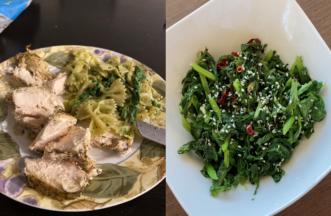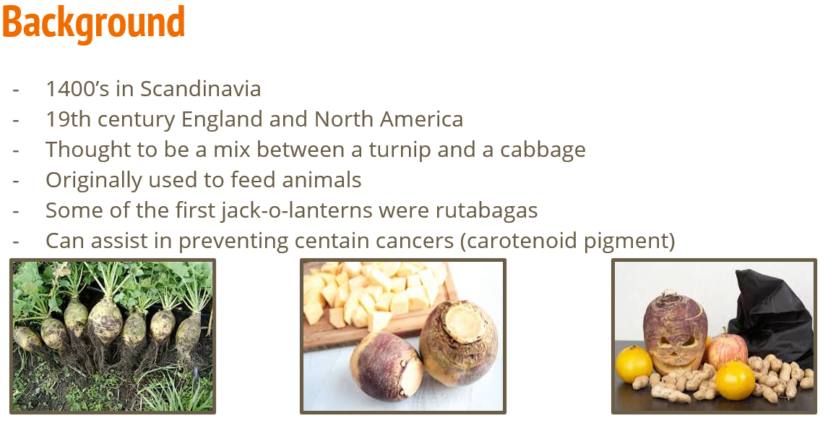The purpose of this publication is to describe an experiential student learning activity that incorporated research, culinary arts techniques, and guest speaker support into an undergraduate, student-led Creative Inquiry course. Culinary instructors, faculty for laboratory or Creative Inquiry courses, and community members can utilize this activity to increase student and stakeholder awareness of heirloom foods and how to cook with them.
Introduction
The multi-week structure of the activity, The Story of Food, focuses on the education of culinary nutrition techniques related to locally grown heirloom vegetables. Heirloom vegetables are cross, or open-pollinated plants passed down through generations. Manufacturers, producers, and consumers began eating hybrid foods, opposed to heirloom varieties, starting in the twentieth century. These foods are commonly seen in the industrialized food system.1 Growing heirloom vegetables, using regenerative agricultural practices, and focusing on agroecology can help establish a sustainable food system to feed the growing population.2 Heirloom vegetables have different tastes, textures, mouthfeels, cooking properties, colors, shapes, and nutrient contents than hybrid produce. These qualities were desirable to the original cultivators. The seeds were then saved, regrown, and passed down through the lineage of the growers
Description of Teaching Activity
Faculty members recognized a unique opportunity for a project assignment to increase knowledge about locally grown produce. The aspects of civic agriculture, the sharing of knowledge, and a sense of community between farmers and consumers are commonly lost in the current food system.4 The project was included as one of four parts of a semester-long undergraduate Creative Inquiry course focused on research and culinary nutrition.
The project objective was for students to effectively articulate the stories of locally grown heirloom vegetables from seed to consumption while engaging local farmers as part of the learning process. Students were each assigned one of eleven heirloom varieties and given three weeks to complete the project requirements. They were instructed to research the assigned vegetable using a variety of classroom resources as well as student sources reference materials and create a written report and a class presentation on the following aspects:
- History
- Seasonality
- Farming practices
- Storage
- Traditional preparations
- Distinguishing characteristics
- Cooking methods
- Nutrient content
The last requirement was creating a plant-based recipe considering vegetable dishes that appeal to the senses of appearance, aroma, taste, and texture. Panels of local farmer organizations and chefs who support regenerative agriculture were organized to assist students. Regenerative farming promotes biodiversity, and practices include crop rotation, cover crops, and reduced usage of tillage and artificial fertilizers. Additionally, students were given digital access to a historical cookbook published in 1871 to provide insight into how food was grown and prepared in the nineteenth century.3
Weekly two-hour virtual meetings were conducted with the class to prepare recipes and taste products. Each student shared their review of a recipe and described the sensory characteristics (i.e., appearance, aroma, taste, and texture) in the virtual meeting environment with the rest of the class group. The students were encouraged to contact the instructor(s) by email with questions or follow-up throughout the project.
Discussion of Outcomes
Two recipes were created for ten varieties, and one was created for the eleventh variety (purple top white globe turnips); thus, the project resulted in twenty-one recipes (table 1). The reports from the students provided a detailed review of the story of heirloom vegetables presented in the view recipes that could be adapted today. The perspective and examples presented by the students create a collection of recipes appropriate to share and replicate. Pictures of some of the recipes and an example of a student presentation are shown in figures 1 and 2.
Table 1. Recipes made by undergraduate students enrolled in the Creative Inquiry course.
| Heirloom Vegetable Variety | Recipe 1 | Recipe 2 |
| Little Finger Carrots | Little Finger Carrot and Ginger Soup | Roasted Little Finger Carrots with Herbs |
| Red Core Carrots | Herbed Carrots with a Balsamic Glaze | Sweet and Spicy Red Core Carrot Stir-Fry |
| American Purple Top Rutabaga | Rutabaga and Kale Soup | Mashed Rutabaga and Rutabaga Spice Cake (2 separate recipes) |
| Bull’s Blood Beets | Beet, Greens, and Quinoa Salad with a Balsamic Vinaigrette | Beet and Caraway Soup |
| Hollow Crown Parsnips | Roasted Parsnips and White Bean Soup | Spicy Honey-Glazed Parsnips |
| Seven Top Turnips | Seven Top Turnip Greens, Tortellini, and White Bean Soup | Southern Style Mustard Greens |
| Purple Top White Globe Turnips | Charred White Globe Turnip Salad with Goat Cheese and a Lemon Vinaigrette | (Only one recipe was created) |
| Wakefield Cabbage | Healing Cabbage Soup | Spicy Lime and Cumin Slaw |
| Yellow Cabbage Collards | Yellow Cabbage Collard Salad with a Lemon Honey Dressing | Southern Style Cabbage Collards |
| Southern Giant Curled Mustard Greens | Mustard Green Pesto with Pecans and Veggie Medley | Stir-Fried Chinese Mustard Greens |
| Rainbow Blend Swiss Chard | Pasta with Swiss Chard, Beans, and Chicken | Swiss Chard Quiche |
Reflection of Outcomes
The students verbally reported enjoying this project. The instructors were pleased with each student’s effort, and overall grades for The Story of Food activity were above average. Students gained secondary knowledge in completing the projects, including simmering, stewing, roasting, various knife skills, and additional cooking techniques. They also made recipes that appealed to the senses and effectively articulated this to the audience. Below is a direct quote from one of the students that demonstrates how they learned not only from their research on heirloom foods but also from hearing the research on vegetables conducted by their classmates.
“I learned a lot about heirloom produce through the activity, especially by talking with farmers and chefs. The process of putting all the information together was a rewarding experience.”
Discussion of the Potential for Adoption in Other Courses
Enriching this project may include more experiential learning activities such as
- Touring local farms
- Assisting in the cultivation of their assigned heirloom vegetables
- Assisting a chef in scheduling how much of their assigned heirloom vegetable may be needed
- Developing a budget for cultivation and sale
- Laboratory nutritional analysis
Experiential learning activities such as those described in this article allow for more individualized student learning, engage students in higher-order thinking, and assist students in developing written and oral communication skills. The Story of Food activity could be adapted to a variety of other agriculture content and applied to similar Creative Inquiry or laboratory courses.
Acknowledgments
Special thanks to Anthony Norcia, Mary Nimmer, and Emily Martin for permitting us to use pictures from their Creative Inquiry presentations.
References Cited
- Dwivedi S, Goldman I, Ortiz R. Pursuing the potential of heirloom cultivars to improve adaptation, nutritional, and culinary features of food crops. Agronomy. 2019 Aug [accessed 2020 Dec];9(8):1–21. https://www.mdpi.com/2073-4395/9/8/441/htm.
- Liere H. Intersection between biodiversity conservation, agroecology, and ecosystem services. Agroecology and Sustainable Food Systems. 2019 Aug [accessed 2020 Dec];41(7):723–760.
- Brown T. Modern domestic cookery: being a collection of receipts suitable for all classes of housewives, together with many valuable household hints. Charleston (SC): Edward Perry; 1871.
- Obach B, Tobin K. Civic agriculture and community engagement. Agriculture and Human Values. 2013 [accessed 2020 Dec];31:307–322. https://link.springer.com/article/10.1007/s10460-013-9477-z.



